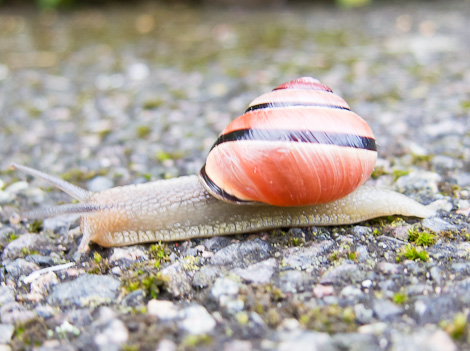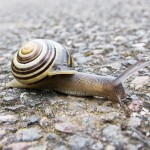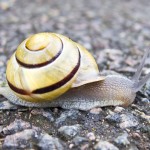Snails – curse of gardeners everywhere, something to try and remove at all costs, and dull, dull dull. As my mother would say, what use are they to anyone? Until recently I was of a similar opinion. I tried to remove them from the garden, tried to encourage hedgehogs in to help do away with them, watered nematodes around my crops (although I admit this was more to deal with slugs than snails) and generally wondered if there was anything good to say about them.
However, a few months ago I started my photography 366 project which involves taking a different photo each day. When out for an evening wander I came across lots of snails making their way across the footpath and spent far too long trying to take photos of them. I was struck by how varied they were and by the number of different colours and patterns. Being me I decided to do some research, the first port of call was my newly purchased copy of Bugs Britannica. This then led me to the internet and a new appreciation of these snails.
 So, to start with, these are banded snails – there are brown lipped and white lipped varieties (although to add to the confusion young brown lipped snails have a white lip). To set the record straight, in common with many slugs, it appears that these snails feed mainly on decaying vegetation. So, although they will munch on my french beans, it seems that the garden snail is a bigger criminal.
So, to start with, these are banded snails – there are brown lipped and white lipped varieties (although to add to the confusion young brown lipped snails have a white lip). To set the record straight, in common with many slugs, it appears that these snails feed mainly on decaying vegetation. So, although they will munch on my french beans, it seems that the garden snail is a bigger criminal.
The variation in colouration and banding pattern also means that they are one of the most genetically studied creatures around, that and the fact that they can be found pretty much everywhere. They come in three colour varieties – brown, pink and yellow and have varying amounts of banding – as illustrated in these photos. This was a basis for a huge online citizen science project carried out in 2009.
 The basis of the project was to compare distributions of the yellow and brown snails and different amounts of banding – unbanded, mid-banding, lots of banding. Observations were made across Europe and compared to historical records. The reason behind the project was to see if the increase in temperature of 1.3oC in the latter half of the twentieth century had affected the distribution of the variations. This is because of the ‘albedo’ effect – which is a measure of the reflectivity of a surface. The theory was that as the climate got warmer there would be an increase in the number of yellow-shelled snails compared to the darker variants and an increase in the proportion of unbanded snails as they evolved to stay cooler.
The basis of the project was to compare distributions of the yellow and brown snails and different amounts of banding – unbanded, mid-banding, lots of banding. Observations were made across Europe and compared to historical records. The reason behind the project was to see if the increase in temperature of 1.3oC in the latter half of the twentieth century had affected the distribution of the variations. This is because of the ‘albedo’ effect – which is a measure of the reflectivity of a surface. The theory was that as the climate got warmer there would be an increase in the number of yellow-shelled snails compared to the darker variants and an increase in the proportion of unbanded snails as they evolved to stay cooler.
 So, what was the result. They separated out the results according to habitat – sand dunes, grassland, hedges and woodland. It was only in the sand dune areas that the proportion of yellow snails increased – in the other areas it would appear that there was sufficient shade and moisture that the increase in global temperature had no effect. In fact a higher proportion of yellow snails were found in the sand dunes compared to the brown and banded snails and there was a decrease in frequency of the yellow snails as the amount of shading available increased; the smallest proportion being found in woodlands.
So, what was the result. They separated out the results according to habitat – sand dunes, grassland, hedges and woodland. It was only in the sand dune areas that the proportion of yellow snails increased – in the other areas it would appear that there was sufficient shade and moisture that the increase in global temperature had no effect. In fact a higher proportion of yellow snails were found in the sand dunes compared to the brown and banded snails and there was a decrease in frequency of the yellow snails as the amount of shading available increased; the smallest proportion being found in woodlands.
With regards to the banding the conclusion was that the data was inconclusive! There is the potential that changes are linked to habitat and predation. As their main predator is the song thrush then changes in the distribution of the song thrush may have an effect. Changes in the habitat that are not easily captured by the survey data may also be responsible for changes. Other things may have an effect… It appears that the banded snail is retaining an element of mystery for further study.
Tag: snail
Hedgehog
Last night I discovered that we have a hedgehog back in the garden. We did have a couple last year, but were worried we had evicted them when we moved the railway sleepers that one of them appeared to be nesting under.
We have since made a waterproof home for them at the bottom of the garden using some spare patio slabs, but until last night had very little evidence that they had forgiven us.
This return should be good news, because, as many of you probably already realise, hedgehogs are a gardener’s best friend and will eat all sorts of grubs, including those pesky slugs and snails. At least he will be earning his keep unlike those lazy frogs!